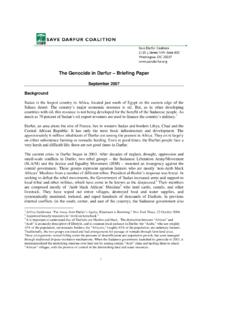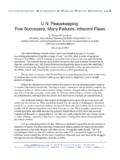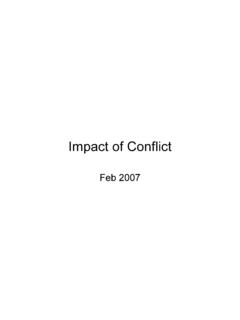Transcription of FACT SHEET: UNITED NATION SECURITY COUNCIL …
1 FACT SHEET: UNITED NATION SECURITY COUNCIL resolution 1769 The UNITED Nations SECURITY COUNCIL passed resolution 1769 by unanimous vote on July 31, 2007. It determined that the situation in Darfur constitutes a threat to peace, and authorized the deployment of a UNITED Nations-African Union Mission in Darfur (UNAMID) under Chapter VII of the UN Charter. UNAMID will be the largest UNITED Nations multilateral peacekeeping force ever deployed, with a total presence of more than 31,000 troops, police, and civilian personnel. UNAMID s Mission The resolution mandates that UNAMID s initial mission is to: Restore SECURITY to allow continued humanitarian assistance; Protect civilians; Monitor ceasefire agreements signed since 2004; Help implement the Darfur Peace Agreement; Ensure an inclusive political process and support AU-UN efforts to broaden and deepen commitment to the peace process; and Monitor and report on the presence of any illegal weapons in violation of the Darfur arms embargo.
2 In addition, resolution 1769 provides long-term missions for UNAMID, including: Provide a secure environment for reconstruction, development, and return of internally displaced persons and refugees to their homes; Promote human rights and basic freedoms; promote the rule of law by strengthening independent judiciary, prison system and development of legal framework; and Monitor the SECURITY situation at borders with Chad and the Central African Republic. In addition, UNAMID will have the authority to take the necessary action to: (1) support early and effective implementation of the Darfur Peace Agreement, prevent disruption of its implementation and armed attacks, and most importantly to protect civilians, without prejudice to the responsibility of the government of Sudan, and (2) protect its personnel, facilities, installations and equipment, and to ensure SECURITY and freedom of movement of its own personnel and humanitarian workers.
3 UNAMID s Structure & Deployment The UN is currently recruiting military personnel and observers, civilian officials, equipment, logistical support, and funding support for deployment of UNAMID. It will consist of up to 19,555 military personnel, including 360 military observers and liaison officers, and an appropriate civilian component including up to 3,772 police personnel and 19 formed police units comprising up to 140 personnel each. UNAMID troops will be predominantly from African countries, with contributions from other countries if African nations are unable to meet the force requirements within the timeline laid out for deployment.
4 UNAMID will incorporate the roughly 7,400 current African Union Mission in Sudan (AMIS) personnel and the UN Light and Heavy Support Packages to AMIS. UNAMID will have a single chain of command, and the UN will provide all command and control structures and backstopping. The UN SECURITY COUNCIL appointed Rodolphe Adada as AU-UN Joint Special Representative for Darfur and Martin Agwai as Force Commander. While full deployment of UNAMID is not expected until mid-2008, there are three immediate deployment deadlines: UN Member States are to finalize their contributions by August 31. No later than October 2007, UNAMID will establish an operations headquarters and be ready to take command of the Light and Heavy Support Packages and cover the cost of AMIS troops.
5 As soon as possible and no later than December 31, 2007 UNAMID will assume authority from AMIS and will achieve full operational capacity. The largest UN mission ever, UNAMID is estimated to cost roughly $ billion a year, plus start-up costs. UN member states will fund the mission through the UN assessment scale. The UNITED States will contribute Challenges UNAMID faces a number of challenges as it moves towards deployment and implementation of its mandate. These include: Darfur s geographic isolation, harsh climate, limited food and water supplies, and poor infrastructure to support UNAMID s mission. More than 30,000 troops, police, civilians and support personnel will need to be housed, fed, and transported in the Darfur region.
6 UNAMID s success is highly dependent on cooperation and compliance by the Sudanese government, which has fought its deployment at every step. Consequences must be developed, enacted, and enforced for Sudanese obstruction of UNAMID s mission. UNAMID s success depends on the Sudanese government and rebel forces moving towards a peace agreement and cease-fire. Some key rebel leaders have been unwilling to participate in the unified UN-AU peace process, to the detriment of the Darfuri people. UNAMID s peacekeeping mission can support, but will not be a substitute for, the political peace process needed to bring an end to violence in Darfur and enable more than 2 million refugees and internally-displaced persons (IDPs) to return to their homes and communities.
7 Key Dates and Deadlines May 5, 2006 Darfur Peace Agreement (DPA) is signed. August 31, 2006 UNSC passes resolution 1706 to expand the mandate of the UNITED Nations Mission in Sudan (UNMIS) to include deployment in Darfur. China, Qatar and Russia abstain. November 16, 2006 At High-Level consultations in Addis Ababa, Ethiopia, the UN Department of Peacekeeping Operations presents a three-phased approach to assist the African Union Mission in Sudan (AMIS) that would culminate in a hybrid UN-AU peacekeeping force. November 30, 2006 AU Peace and SECURITY COUNCIL endorses a hybrid force at a meeting in Abuja, Nigeria.
8 December 19, 2006 Presidential Statement by UNSC endorses hybrid force. June 5, 2007 Report of the Secretary-General and the Chairperson of the African Union Commission on the hybrid operation in Darfur (S/2007/307) is released. UNAMID gets its mandate from paragraphs 54 and 55 of this report. June 12, 2007 Sudan accepts hybrid multilateral force. July 31, 2007 UNSC passes resolution 1769 by a unanimous vote to authorize the UNITED Nations-African Union Mission in Darfur (UNAMID). August 31, 2007 The deadline set within resolution 1769 for finalization of troop commitments is missed. October 2007 The deadline set within resolution 1769 for establishment of an operations headquarters, and for the UN s assumption of command of the Light and Heavy Support Packages and coverage of the cost of AMIS troops.
9 October 27, 2007 The proposed date of a new set of peace talks to take place in Libya, under the unified guidance of the UN and AU. December 31, 2007 The deadline set within resolution 1769 for UNAMID full assumption of authority from AMIS and achievement of full operational capacity, while acknowledging that the deployment of forces will continue through the early months of 2008. Briefing Paper: What next in Darfur? September 2007 Background The situation in Darfur has gone from bad to worse since the Darfur Peace Agreement was signed in May 2006. For example: Murder, rape, bombings, forced displacement, and ethnic cleansing continue to occur throughout Darfur, and across Sudan s borders in Chad and the Central African Republic.
10 Despite promises to the contrary, the Sudanese government of President Omar al-Bashir has continued to obstruct international efforts to end the conflict and provide SECURITY and protection for the Darfuri people. Sudan s National Congress Party continues to pursue a military solution in Darfur. Displacement is on the rise. More than 2 million Darfuris have been dislocated because of the violence, including an estimated 500,000 in the last 15 months, and are living in crowded refugee camps in Darfur and eastern Chad. Humanitarian and relief workers who are providing housing, food, water and medical treatment have been targeted by both government-sponsored militias and rebel groups.






